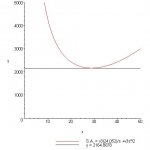Hello,
I am having difficulty with this question:
A chocolate company needs to manufacture cardboard containers with the shape of equilateral-triangular prisms and that have a volume of exactly 6013mL. What are the optimum dimensions (in cm) such that a minimum amound of cardboard is used?
Answers:
Triangle edge = 28.87cm
Prism length = 16.67cm
I am guessing since v=21abh and sa=(3/4)s2+(s+s+s)h (I think)
So, I want to minimise the area, so this is the equation that will be differentiated, but it has 3(?) variables, height of the rectangle, area of the triangle and width of the triangle.
As you can see, I really am confused!!
Any help would be greatly appreciated.
Thankyou
Miss_B
I am having difficulty with this question:
A chocolate company needs to manufacture cardboard containers with the shape of equilateral-triangular prisms and that have a volume of exactly 6013mL. What are the optimum dimensions (in cm) such that a minimum amound of cardboard is used?
Answers:
Triangle edge = 28.87cm
Prism length = 16.67cm
I am guessing since v=21abh and sa=(3/4)s2+(s+s+s)h (I think)
So, I want to minimise the area, so this is the equation that will be differentiated, but it has 3(?) variables, height of the rectangle, area of the triangle and width of the triangle.
As you can see, I really am confused!!
Any help would be greatly appreciated.
Thankyou
Miss_B

